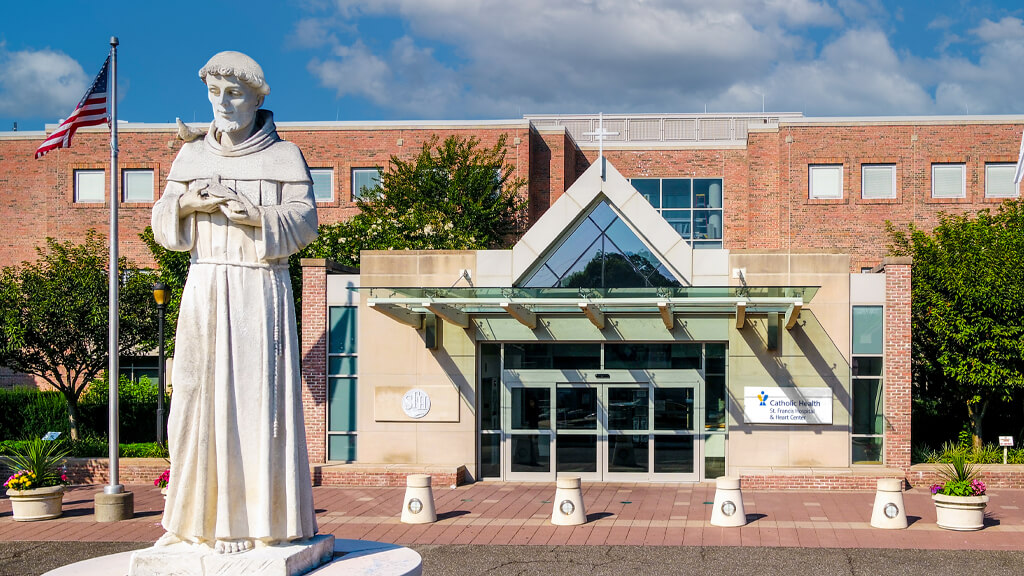Full Spectrum of Care Across Long Island
Catholic Health is the leader in brain, spine, stroke and neurovascular care on Long Island. Our board-certified neurologists and neurosurgeons provide comprehensive care to patients with neurological conditions affecting the brain, spine and nervous system. You can trust our compassionate team of experts for accurate diagnosis and treatment to help you heal and live a healthy and productive life.
Our comprehensive program includes treatment of back and neck pain, tumors of the brain and spine, epilepsy and seizures, neuromuscular disorders, spinal disorders, and movement disorders like Parkinson's disease. Our neurointerventional specialists treat patients who have had an aneurysm, cerebral hemorrhage or stroke.
Our Brain & Spine Program
Catholic Health's brain and spine team uses nonsurgical and surgical treatments customized to the specific needs of each patient to ensure the best outcomes and shortest recovery times.
Our board-certified neurosurgeons are leaders in both minimally invasive surgeries and complex surgical procedures for the brain. They use the latest and most innovative technologies to bring expert and comforting care to Long Islanders.
Nonsurgical conditions we treat include:
- Back pain
- Neck pain
- Scoliosis
- Compression fractures
- Degenerative disc disease
- Herniated discs
- Spinal stenosis (narrowing of the spinal canal)
- Spondylolisthesis (lower vertebra slips forward over the vertebra below)
Nonsurgical treatments we offer include:
- Cervical epidural steroid injection
- Cervical radiculopathy (pinched nerve)
- Lumbar epidural steroid injection
- Lumbar radiculopathy (sciatica)
- Pain management
Our surgical treatments include:
- Anterior cervical discectomy and fusion—relieves painful pressure on spinal nerves
- Anterior lumbar interbody fusion—treats back or leg pain caused by degenerative disc disease
- Cervical posterior foraminotomy—relieves painful pressure caused by a herniated or degenerative disc
- Laminectomy—relieves the pain of stenosis (narrowing of spinal canal)
- Lumbar disc microsurgery—relieves sciatica pain
- Posterior lumbar interbody fusion—treats pain caused by degenerative disc disease
- Spinal cord stimulator implant—electrical impulses relieve chronic pain of the back, arms and legs
- Spinal fusion (lumbar spine, for treatment of spondylolisthesis)—stabilizes your spine
- Transforaminal lumbar interbody fusion—treats back or leg pain caused by degenerative disc disease
- Vertebroplasty—stabilizes a compression fracture of the spine
Our brain (neurointervention and stroke) surgical treatments include:
- Aneurysm clipping
- Arteriovenous malformation—abnormal connection between blood vessels
- Stereotactic radiosurgery for arteriovenous malformation
- Brain aneurysm
- Cerebral cavernous malformation—mass of enlarged blood vessels in the brain or spinal cord
- Coil embolization for brain aneurysm
St. Charles Hospital (Port Jefferson, NY) offers unique, specialized care for Long Islanders.
The only muscular dystrophy care center on Long Island. Treats adults and children living with muscular dystrophy and other neuromuscular disorders.
Treats adults diagnosed with Parkinson's disease and other movement disorders.
A National Association of Epilepsy Center level 4 epilepsy center. Provides complex forms of intensive neuro-diagnostic monitoring and extensive medical, neuropsychological and psychosocial treatment to diagnose and treat epilepsy as well as seizure disorders and conditions that mimic seizures.
When every second counts, our Catholic Health stroke experts and neurointervention specialists provide rapid diagnosis and treatment.
All Catholic Health hospitals are New York State Department of Health-designated stroke centers and meet the American Heart Association/American Stroke Association’s “Get with the Guidelines®” standards for rapid stroke diagnosis and stroke treatment. We are nationally recognized by The Joint Commission and have been awarded the Gold Seal of Approval for our expert care.
The Gary H. Richard and Family Stroke & Brain Aneurysm Center of Long Island at Good Samaritan University Hospital (West Islip, NY) is designated by both the Joint Commission and New York State Department of Health.
St. Francis Hospital & Heart Center is designated by the Joint Commission and New York State Department of Health as a Thrombectomy Capable Stroke Center.
Neurointervention specialists treat patients who have had a stroke or cerebral hemorrhage as well as cerebral aneurysm, blood vessel malfunction, or any abnormality that can occur in the brain, spinal cord and neck.
Catholic Health offers specialized rehabilitation and unique treatments and services at St. Charles Hospital (Port Jefferson, NY)—Long Island's leader in inpatient and outpatient medical rehabilitation.
Specialty rehabilitation programs include:
The Schroth Method for Scoliosis
A promising rehabilitation technique that slows down or halts the curvature of the spine and can straighten the spine. It may even eliminate the need for back surgery. The Schroth Method can be used if you are newly diagnosed with scoliosis, wearing a back brace, or preparing for or recovering from surgery.
This method helps:
- Decrease pain
- Improve blood circulation
- Improve the stability of your posture and spine strength
- Increase mobility
- Make it easier to breathe
Downtown St. Charles is the first and only rehabilitation module of its kind on Long Island that simulates a typical home and downtown community setting to let patients practice real-world adaptive skills while they are still in the hospital.
Our Team and Approach
At Catholic Health, our coordinated-care model gives you access to a multidisciplinary team of compassionate experts who ensure you are fully involved in your care. This includes nationally-recognized orthopedic physicians in joint replacement surgery and sports medicine as well as pain management teams who alleviate chronic pain or discomfort from neurological conditions.
We are also leaders in physical therapy and rehabilitation, providing expert and specialized care in occupational, physical and speech/swallowing therapies.
- Neuro-interventional specialists—treat complex neurological problems such as aneurysms and stroke
- Neuro-oncologists—treat cancers of the nervous system
- Neurologists—treat diseases of the brain, spinal cord and peripheral nerves
- Neurosurgeons—specialize in the surgical treatment of nervous system disorders
- Orthopedic spine surgeons—specialize in surgery of spinal conditions
- Pain medicine specialists—treat and manage pain
- Physiatrists and rehabilitation therapists—specialize in physical therapy and rehabilitation
Brain & Spine Program Locations

St. Francis Hospital & Heart Center
Roslyn, NY

Good Samaritan University Hospital
West Islip, NY

Mercy Hospital
Rockville Centre, NY

St. Catherine of Siena Hospital
Smithtown, NY

St. Charles Hospital
Port Jefferson, NY

St. Joseph Hospital
Bethpage, NY

